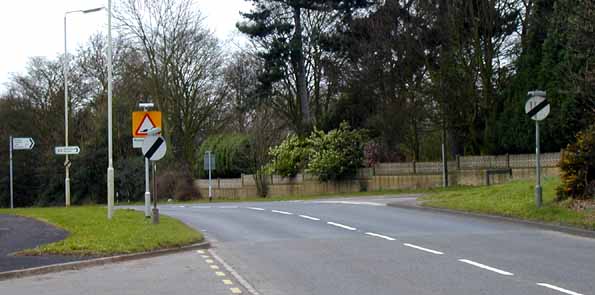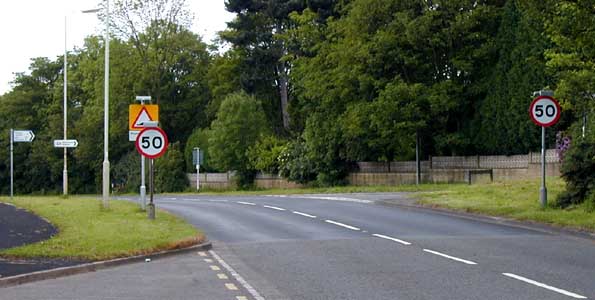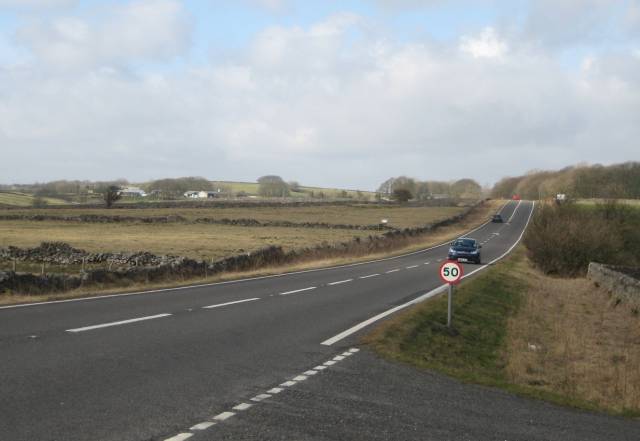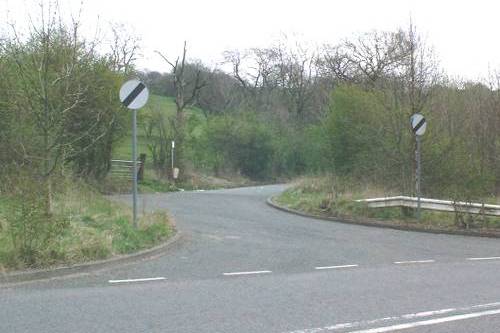The New Stealth NSL
The 60 mph NSL on rural single-carriageway roads is an endangered species

Now you see it!
And now it's gone!
(Photos taken on the A5127 at Shenstone in Staffordshire, courtesy of www.speedcam.co.uk )

Introduction
The Highway Code makes it clear that, on single-carriageway roads without street lighting, that is, the vast majority of rural roads, the default National Speed Limit is 60 mph. A lower speed limit will only apply if specifically signed. The novice driver might be forgiven for imagining that, once out of town, the familiar  sign would be routinely encountered. Yet, in more and more parts of the country, they are fast becoming as rare as hens' teeth.
sign would be routinely encountered. Yet, in more and more parts of the country, they are fast becoming as rare as hens' teeth.
In 1997, there were widespread reports that the newly-elected Labour government were planning to reduce the national speed limit on single carriageway roads from 60 to 50 mph. Fortunately, nothing came of this, and many drivers will have breathed a sigh of relief. However, since then, more and more highway authorities have been reducing limits within their areas on a piecemeal basis, to the extent that now, in many localities, 50 mph is now effectively the default limit for rural main roads.
History
Before the late 1990s, it was very rare to encounter a 50 mph limit on a rural main road, and indeed the only ones I can think of, such as the A5080 between Widnes and Warrington, were justified by a level of development that was too sparse for a 40 limit but not truly rural. However, in 1992 the then Conservative government scrapped the requirement to gain Department of Transport approval for speed limit changes, and highway authorities, at first slowly, began to realise this gave them a new freedom to implement their own speed limit policies that often contravened the national guidelines.
One of the first major schemes on this kind that I noticed was in 1998-99 when the Highways Agency reduced the speed limit along the entire length of the A523/A52 between Leek and Derby, and the A6 between Chapel-en-le-Frith and Derby, from NSL to 50 mph (except for a couple of dual carriageway sections on the A6). In the case of the A523/A52 this was backed up by an intimidating forest of Gatsos. This, on what I had previously regarded as "fast", high-quality main roads, was probably the single biggest factor in convincing me that the authorities really did have it in for motorists and stimulated my interest in combating their anti-car policies.
Since then, the trend has spread across areas all over the country. Many more Peak District roads such as the famous A57 Snake and A537 Cat & Fiddle passes have succumbed. In fact, during 2007 and 2008, Derbyshire have made 50 mph the default limit on all their formerly NSL single-carriageway A-roads in the Peak District, including other good roads such as the A623 from Chapel-en-le-Frith to Baslow. All the single-carriageway main roads between Greater Manchester and the Blackburn/Burnley area are now 50 limits. The entire length of the A140 through Suffolk has become a 50. Oxfordshire is working through a programme of making all its rural A and B roads 50s, and something similar is happening in Surrey. Obviously I don't have direct experience of every area, and on recent visits both North Yorkshire and Durham so far seemed to be largely immune, but I see reports of this happening all over the country.
Initially, this was being done in contravention of the official guidelines contained in Department of Transport Circular Roads 1/93. This suggested that 50 mph limits are appropriate for roads that are "Lightly built up. Some frontage development. Development not essential but maybe cafes or filling stations or other features which attract traffic, e.g. parks and sports grounds." which suggests that the key factor justifying a 50 mph limit is the level of development or the frequency of property accesses.
New Guidelines
However, the government's new speed limit guidelines, contained in DfT Circular Roads 1/06, effectively legitimise the practice of the last decade. According to these guidelines, the following criteria should be used for setting speed limits on rural single-carriageway roads:
Upper tier A and B roads
This clearly gives a highway authority justification, if they need it, to impose a 50 mph limit on pretty much any traditional rural A or B-road with the usual mix of side turnings, field entrances and occasional properties. It also has the potential to lead to apparent inconsistencies when two roads of similar appearance are given different speed limits on the basis of their accident record. Typically, a high proportion of accidents on rural roads relate to misjudgments at junctions and, if the accidents are not mainly speed related, it is hard to see what benefit cutting the limit will bring even if it achieves a relatively high level of compliance.
It is not difficult to see in a few years' time that we will reach a situation where the vast majority of "normal" rural A-roads have 50 limits, with 60 being confined to limited stretches of new-build roads, bypasses and roads that have been substantially upgraded, such as the A361 North Devon Link Road, A616 Stocksbridge Bypass or A303 Ilminster bypass.
Yet there will still be a sprinkling of minor A-roads and B-roads that have not been reduced simply because the local authorities haven't had the time or money to get round to them yet, and most unclassified roads that realistically they never will. So we will have the absurd situation where there is a "reverse rural speed hierarchy" with, broadly speaking, the lower quality roads having the higher speed limit. And the countryside will be blighted with vast numbers of expensive and unsightly speed limit signs.
The Irish Experience
If you were starting from scratch surely it would make more sense to follow the Irish approach of having 50 mph as the default rural limit and specifically signing a higher limit on those roads appropriate for it. Obviously I would vehemently oppose such a retrograde policy, but at least it is logical and consistent. At present the British government are avoiding any open debate on the subject and clinging to the concept that the default rural limit is 60 mph when, effectively, they are introducing a 50 mph single-carriageway NSL by stealth.
Indeed, this is in effect what has been done in the Republic of Ireland. Historically they had a fairly similar speed limit regime to the UK, but for a number of years had the characteristically Irish anomaly of metric distance signs, but Imperial speed limits. However, in 2005 they grasped the nettle and converted all speed limits to metric. The default speed limit on rural roads was reduced from 60 mph to 80 km/h (50 mph), but “National Roads” were given a limit of 100 km/h (62 mph). The traditional NSL signs were dispensed with, and all limits were specifically signed, but there is no requirement for repeaters in rural 80 km/h zones. Now I disagree with this, and fail to see why all rural roads could not have a default limit of 100 km/h. However, it is at least logical and reduces the need for signage clutter. I have only visited the Republic of Ireland once (in 1994) and in general found its roads quiet, but of a poor standard. In reality, there is probably virtually no enforcement of the rural 80 km/h limit and, whatever the official limit, a road without repeaters is better than one with them.
If applied in the UK, then the mileage of rural roads given a 60 as opposed to a 50 limit would be very small, and in practice we would end up worse off than we are today.
Will it improve safety?
Obviously the claimed objective of these speed limit reductions is to improve safety. However, as stated before, it is likely that the majority of accidents on such roads will not be speed related anyway, and even if they were, how many are caused by generally responsible drivers travelling between 50 and 60 mph? There also seems to be a basic presumption that motorists are inherently irresponsible people, and that safety will only be improved if they are further controlled and restricted.
In many cases, reductions in accident rates after cutting the speed limit to 50 mph will result from a kind of "Hawthorne effect" whereby any environmental change is likely to result in a short-lived improvement. Also, in many cases, speed limit reductions, which need new signage anyway, are accompanied by a general refreshment of signing and marking. If only a relatively small mileage of rural roads had 50 limits, then when encountering one drivers might well increase their attention level on the grounds that this must be an unusually dangerous stretch of road. However, once they become general this effect will cease to apply.
On the face of it, the idea that slower speeds must improve safety seems obvious, but in reality, it is not as simple as that. The basic principle of safe driving is that you must be able to stop comfortably within the distance you can see, taking into account any hazards you are likely to encounter. This means, that for any given stretch of road, a driver can determine an appropriate safe speed based on the characteristics of the road and the number and nature of the hazards that may be encountered along it. The fact that narrow, twisty lanes where safe speeds rarely exceed 30 mph often have a nominal 60 mph limit does not in practice cause a safety problem.
Research has shown that, while the most dangerous drivers on a stretch of road are the fastest 10%, the next most dangerous group are the slowest 10%, with the accident risk then steadily reducing as you move up the speed graph, with the safest drivers being those in the 80-90% speed range. These are drivers who are not reckless but are able to handle their vehicles in a confident, purposeful way and are fully aware of what is going on around them. This is why experience has shown that speed limits should be set no lower than at or around the 85th percentile speed of all drivers on a road. If you slow down already safe drivers, they will not become any safer, and indeed may become less safe if they are frustrated or distracted.
Provided that drivers are travelling at an appropriate speed for the road, there is no safety benefit to be gained from slowing them down further. There is plenty of evidence to show that unrealistically low speed limits actually increase accidents. When in the USA the national 55 mph speed limit on interstate highways was removed, leading individual states to impose limits typically of 65 mph or 75 mph, the accident rate fell. Similar results were often found in the UK in the 1960s and early 1970s when suburban 30 limits were increased to 40 mph.
Travel times
It is sometimes claimed that, by smoothing out traffic flow and reducing bunching, 50 mph limits may in fact improve journey times. But closer examination reveals this proposition to be absurd. Single-carriageway rural roads virtually never reach the situation often found on motorways where weight of traffic leads to stop-start waves running along the road, and even when they do the overall speed is way under 50 mph.
Obviously, at busy times, when overtaking opportunities are non-existent, real-world travel times will be no worse. However, on the vast majority of these roads, for much of the day that is not the case, and the reduction of the permissible maximum speed combined with the restriction of opportunities for overtaking will mean that journey times for the driver who wishes to make good progress while not straying too far outside the law will be significantly extended. Over a 10-mile journey, typical of many rural commutes, a reduction in the achievable average speed from 50 mph to 42 mph (proportionate to a 60-50 mph cut) would cost 5 minutes a day, or 20 hours a year. A long cross-country journey on roads cut to 50 mph could easily take an hour longer than it did before.
Why it is a bad idea
The arguments against this policy can be summed up as follows:
Conclusion
The general application of blanket 50 mph limits to rural main roads is a thoroughly bad policy. It does nothing for safety, increases journey times, erodes respect for the law and degrades the environment. It is also a manifestation of the general anti-car and anti-driver attitude in public policy. However, unfortunately in more and more areas, 50 mph rural roads are becoming the norm rather than the exception, and effectively the National Speed Limit is being slashed by stealth. Unless there is a major change in in official policy to a more sensible approach to speed limits, which appears unlikely in the foreseeable future, regrettably it seems to be something that we are stuck with.

The A515, a high-quality primary A-road where a 50 mph limit was imposed by Derbyshire Council Council in Spring 2007

Imposing 50 limits on rural main roads leads to the absurd sight of NSL signs at the entrance to small, twisty lanes